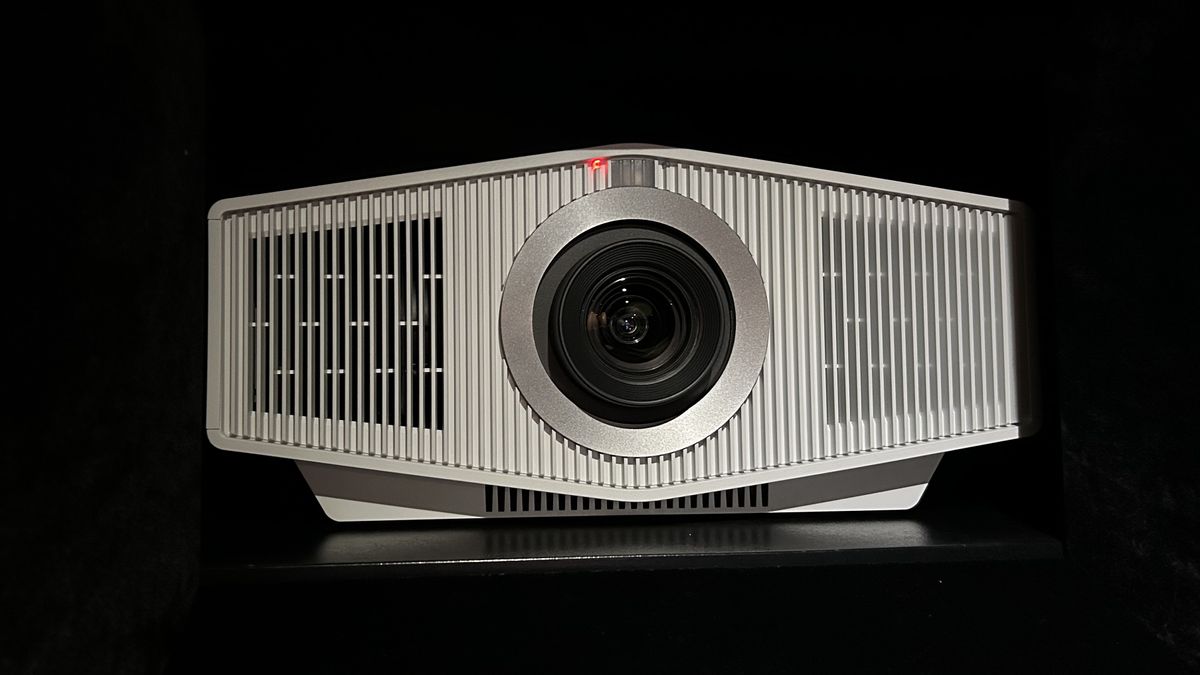
Sony Bravia Projector 8: two-minute review
The Sony Bravia Projector 8 (VPL-XW6100ES) is the latest addition to the company’s lineup of native 4K projectors, all of which use the Z-Phosphor laser light source. This new beamer, along with the flagship Bravia Projector 9 (VPL-XW8100ES), adds several key features that bring the brand’s higher-end models in line with their chief competitors among the best 4K projectors, the JVC DLA-NZ800 and JVC DLA-NZ900.
Brightness for the Sony Projector 8 has been increased to 2,700 lumens and both models now use Sony’s professional-grade XR Processor. One of the key benefits is genuine dynamic tone mapping for a superior HDR experience.
The Projector 8 and 9 retain the same chassis and Advanced Crisp-Focus (ACF) lens, motorised lens controls and lens memories as the previous generation, but unlike the JVC projectors, they don’t support HDR10+ high dynamic range or 3D.
The Projector 8’s design is the same as previous generations, but the compact chassis remains well-built. The menu system is easy to navigate, installation is flexible, and the backlit remote control makes this beamer a pleasure to operate. The connectivity has been upgraded and now includes two HDMI 2.1 inputs, which means the Projector 8 accepts signals with higher frame rates up to 4K 120p – great news for next-generation console and high-end PC rig gamers.
The inclusion of 4K 120p isn’t the only good news for gamers, with the Projector 8 supporting ALLM. As a result, it automatically goes into the game mode when a console is detected, and the input lag is an incredibly low 10ms. All of this finally makes this beamer the ideal companion to the brand’s own PlayStation 5 game console, as well as other consoles and PC gaming rigs.
It’s not perfect of course. There’s no HDR10+ or 3D support, the colour gamut could go wider, the black levels dig a little deeper, and shadows retain more detail, but overall this high-end beamer delivers the big screen goods. In fact, its smooth motion, superior processing, fast responses, and improved HDR are sure to please even the most demanding cinephile or competitive gamer.
Sony Bravia Projector 8 review: price and release date
- First available: October 2024
- Price: £15,999 / $15,999 / around AU$21,170
The Sony Bravia Projector 8 (VPL-XW6100ES) is the new mid-range model in the brand’s line-up of home cinema projectors and is available now in a choice of matte black or white finishes. The Projector 8 currently retails for £15,999 in the UK or $15,999 in the US.
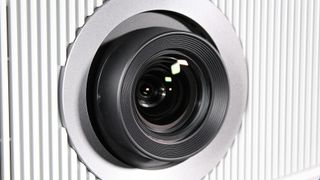
Sony Bravia Projector 8 review: Specs
Screen sizes supported: | Up to 150 inches |
Brightness (specified): | 2,700 lumens |
HDR support: | HDR10, HLG |
Optical technology: | Z-Phosphor laser, SXRD |
Smart TV: | NA |
Connections: | 2 x HDMI 2.1 , 2x USB-A (powered), IR, RS-232C, Ethernet |
Dimensions (W x H x D): | 460 x 210 x 517mm (18.1 x 8.2 x 20.3 inches |
Weight: | 14kg/30.8 pounds |
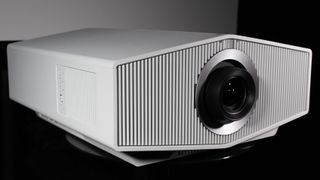
Sony Bravia Projector 8 review: design
- Advanced Crisp-Focus (ACF) lens
- Motorised lens controls and memories
- Backlit remote control
The Sony Projector 8 looks identical to the brand’s previous generations, with the same angled design and centrally-mounted lens. There are air intake grilles at the front, exhaust vents at the rear, and some basic controls on the left-hand side as you face the lens.
The Projector 8 measures 460 x 210 x 517mm (WxHxD), and weighs in at 14kg. Sony offers a choice of matte black or matte white, and you can also choose between a stand or ceiling mount. The build quality is good, although it feels less substantial when compared to the JVC NZ800.
The Projector 8 uses the Advanced Crisp-Focus (ACF) 70mm lens introduced on earlier models, which is designed to resolve more detail. The lens controls are also motorised, making setup easier, and there are lens memories to create different aspect ratios if you use a 2.35:1 screen.
The connections are all located in a recess along the bottom left-hand side as you face the projector. Here you’ll find two HDMI 2.1 inputs, which is a welcome addition, along with an Ethernet port and RS-232C connector, a 12V trigger, an IR input jack, and a USB port for power.
The provided remote is the same large and backlit zapper included with previous generations of Sony beamers. The buttons are laid out sensibly, it’s comfortable to hold and use with one hand, and includes all the controls you’ll need to set up and operate the Projector 8.
- Design score: 5/5
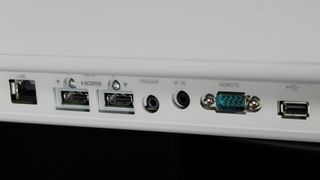
Sony Bravia Projector 8 review: features
- Z-Phosphor laser light source
- Dynamic HDR Tone Mapping
- Support for 4K 120Hz high frame rate
The Sony Projector 8 uses the brand’s current 0.61-inch SXRD chip to deliver native 4K (3840 x 2160) images. The projector has a refresh rate of 120Hz, and thanks to the addition of the two HDMI 2.1 inputs it can now support higher frame rates up to 4K 120p.
The Projector 8 also uses a Z-Phosphor laser light source, with an increased claimed brightness of 2,700 lumens and a claimed lifespan of up to 20,000 hours. That basically means you could watch a film a day for the next ten years without worrying about the image dimming like a lamp or bulb.
The inclusion of wide dynamic range optics and Sony’s XR Triluminos Pro technology promises deeper blacks, more saturated colours and improved contrast ratios. Sony’s professional-grade XR Processor also promises advanced image processing and real-time optimisation of the picture.
Thanks to the addition of the XR Processor the Projector 8 has XR Clear Image processing for intelligent upscaling and noise reduction, along with improved HDR thanks to image cross-analysis, depth mapping and focal point recognition. There’s also XR Deep Black laser dimming and XR Dynamic Tone Mapping for optimised HDR10 based on analysis of the incoming signal.
There’s Motionflow frame interpolation for fast-paced sports action and a low-latency mode for gaming. In addition to the support for 4K 120p high frame-rate gaming, the Projector 8 also has ALLM (auto low latency mode) that puts it into game mode when a games console is detected.
- Features score: 4
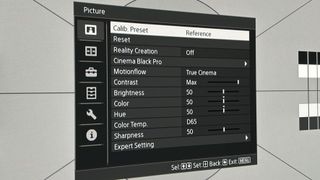
Sony Bravia Projector 8 review: picture quality
- Bright and detailed pictures
- Impressive HDR tone mapping
- Very low input lag for gaming
The Sony Projector 8 (VPL-XW6100ES) delivers awesome big-screen pictures thanks to its native 4K (3840 x 2160) resolution and Advanced Crisp-Focused (ACF) 70mm lens. This results in detailed and distortion-free images, along with wider dynamic range optics. All of this means you’ll get pin-sharp resolution across the entire screen – no matter how big that screen is.
If you have a really large screen, there’s no need to worry, because this beamer has a Z-Phosphor laser light source that can reach an extremely bright 2,700 lumens. It also has a claimed lifespan of 20,000 hours, so you’ll never have to worry about changing a lamp, plus the laser itself delivers a consistent colour performance and doesn’t dim significantly over its long average lifespan.
The Reference picture mode proves very accurate out of the box, and the extensive calibration controls can be used to dial in a near-perfect picture. The black levels are not as good as the JVC NZ800, and I measured the Projector 8’s contrast ratio at 12,000:1. Sony only quotes a dynamic contrast ratio of infinity to one, but this is achieved by turning the laser off, which doesn’t represent mixed content.
The big selling point of a Sony projector is its image processing, and the XR Processor doesn’t disappoint. When watching a high quality 1080p source, you’ll be rewarded with an upscaled picture that makes full use of the projector’s more than eight million pixels, producing images that are expertly rendered so they appear clean, detailed and free of unwanted artefacts or noise.
Sony’s Reality Creation detail enhancement applies sharpening to any resolution, including 4K, but is so sophisticated that it achieves this without introducing distracting artefacts. Motion handling is class-leading, appearing fluid and free of judder or other issues, even without engaging Motionflow. Although for fast sports the frame interpolation feature can be beneficial.
The Projector 8 supports HDR10 and HLG, but not HDR10+. The addition of dynamic tone mapping is most welcome, performing frame-by-frame analysis of incoming HDR signals, and adjusting the tone mapping dynamically through pixel processing and the laser power. The results are impressive for a projector, bringing out details in the darkest and brightest parts of the picture.
While I was generally impressed by the picture quality, I do feel that to get the most out of this beamer you need to use all the processing. The Reference mode, which bypasses a lot of the processing, often appeared flat and lifeless, but when switched to Film 1 or Film 2 it was a different story. The images burst into life with detail, depth and colour that really add to SDR and HDR.
Watching Passengers reveals a detailed native 4K image with well rendered HDR and rich colours that retain plenty of depth. The same is true with the saturated primaries in The Greatest Showman, which the Projector 8 handles with skill. It’s only when watching a darker film like The Batman that the weaker blacks of the Projector 8 are laid bare, but at least the shadows are free of crush and the peak highlights don’t suffer from loss of detail or clipping.
The Projector 8 is a great choice for gamers thanks to its bright and detailed images, as well as its peerless motion handling. The performance with SDR is superb, while HDR gaming is exceptional due to the laser light source and HDR enhancements. The overall gaming experience is smooth and responsive thanks to a dedicated game mode that delivers an input lag of 18ms with 4K 60p, and just 10ms with 4K 120p. Both these latency measurements are lightning-fast for a projector, and better than many TVs.
- Picture quality score: 4.5/5
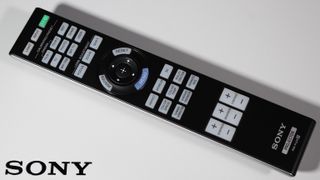
Sony Bravia Projector 8 review: value
- Priced to directly compete with superior JVC NZ800
- Expensive when compared to very similar JVC NZ700
The Sony Bravia Projector 8 (VPL-XW6100ES) is priced to compete directly with the JVC DLA-NZ800, which also costs £15,999/$15,999. However, the NZ800 does have the edge due to its all-glass lens, deeper blacks, superior dynamic tone mapping, and support for both HDR10+ and 3D.
The Projector will also face serious competition from JVC’s DLA-NZ700, which currently retails for £9,499/$8,999. The NZ700 isn’t as bright at 2,300 lumens, but it delivers better contrast and HDR tone mapping, and it supports HDR10+. However, the Sony still has the edge with gaming thanks to its lower input lag and support for 4K 120p compared to the JVC, which is limited to 4K 60p.
- Value score: 4/5
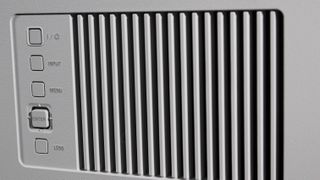
| Header Cell – Column 0 | Notes | Rating |
|---|---|---|
Features | Long-life laser light source, dynamic HDR tone mapping, advanced frame interpolation, and superior image processing | 4/5 |
Design | Compact chassis, backlit remote, excellent build quality, easy setup and motorised lens controls with memories | 5/5 |
Picture quality | Good out-of-the-box accuracy and super-bright pictures produce enjoyable HDR, although the black levels aren’t great | 4.5/5 |
Value | Faces stiff competition from JVC NZ700, which has better HDR support and 3D, but lower brightness | 4/5 |
Should I buy the Sony Bravia Projector 8?
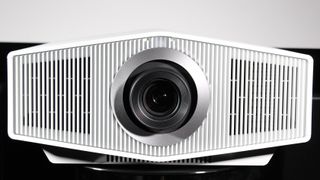
Buy it if…
Don’t buy it if…
Also consider…
| Header Cell – Column 0 | Sony Projector 8 | Epson QB1000 | Epson LS1200 | JVC DLA-NZ800 |
|---|---|---|---|---|
Price: | £15,999 / $15,999 | £4,799 / $7,999 | £4,399 / $4,999 | £15,999 / $15,999 |
Screen sizes supported: | up to 150 inches | 50 to 300 inches | 50 to 130 inches | 30-150 inches |
Brightness (specified): | 2,700 lumens | 3,300 lumens | 2,700 lumens | 2,700 lumens |
HDR support | HDR10, HLG | HDR10+, HDR10, HLG | HDR10+, HDR10, HLG | HDR10+, HDR10, HLG |
Optical technology: | Z-Phosphor laser, SXRD | Laser 3LCD | Laser 3LCD | Laser D-ILA |
Smart TV: | N/A | N/A | N/A | N/A |
Connections: | 2 x HDMI 2.1 , 2x USB-A (powered), IR, RS-232C, Ethernet | 2 x HDMI 2.1 (1 with eARC), 2xUSB-A (powered), RS-232C, Ethernet | 2xHDMI 2.1 (1 with eARC), 1 x powered USB, Ethernet, RS232-C, 12-volt trigger output | 2x HDMI 2.1 |
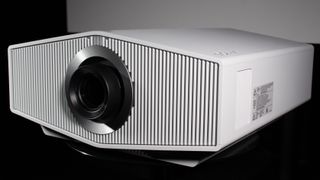
How I tested the Sony Bravia Projector 8
- Measured with Calman calibration software
- Evaluated using SDR and HDR content
- Reviewed in a dedicated home cinema
As with all my TV and projector reviews I use a combination of subjective viewing and objective measurements against the industry standards. For projectors, I also do all my testing in a dedicated home cinema with a completely blacked-out environment and high-quality screen.
The subjective testing is based around watching a variety of familiar scenes, primarily sourced from 4K and 1080p Blu-rays, plus the Spears & Munsil UHD Benchmark 4K disc. Any test scenes have been specifically chosen to evaluate a display’s black levels, contrast performance, colour accuracy, upscaling, image processing, motion handling, and HDR tone mapping.
For the objective testing, I measured the Projector 8’s brightness, greyscale and colour gamut in SDR, before doing the same in HDR. I also evaluated the accuracy of the HDR tone mapping, along with the colour gamut coverage for DCI-P3. To do this I used a pattern generator and colour meter combined with Portrait Display’s Calman calibration software. I measured the Projector 8’s input lag in milliseconds using a specialised Leo Bodnar tester.
First reviewed: February, 2025
